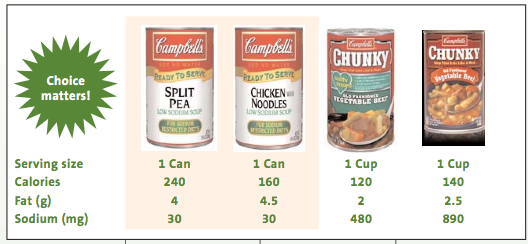Food News: Look At The Right Numbers
 Real life examples of food packages often give great learning lessons to focus on the numbers that really matter - the back of the box or can rather than marketing hype. Saturated fat, sodium and calorie density are what is really important for the big picture of a healthful diet. Our lesson this month is from soup since cooler weather is around the corner.Campbell’s line of Chunky soups now boasts:• 23 soups that have a full serving of vegetables and 100 percent lean meat•More than 30 soups that have a full serving of vegetables• More than 30 soups that have 100 percent lean meat• More than 30 soups that are a good source of proteinWe do agree that using more veggies and lean meat are a great idea for soup. But we do question the sodium. The sodium content for the Chunky Healthy Request Beef and Vegetable Soup is 480 mg per cup for 120 calories. That is a ratio of 4 mg of sodium per 1 calorie. A lower ratio is certainly better. Regular Beef with Country Vegetables Chunky Soup has 890 mg of sodium per cup and the calories and fat are not that different. 50% less sodium is good but not good enough for us to buy it. If you have the right ingredients on hand, it takes little time to throw them in a pot to make soup without salt, and not that much more than to open a can and heat it up. To be fair, Campbell’s does make a low-sodium variety of soups. Our choices out of these would be Chicken with Noodles Soup that has just 160 calories, 4.5 g fat, 1.5 g saturated fat and 140 mg sodium per can; Chunky Split Pea Soup has 240 calories, 4 g fat, and 30 mg sodium per can; Chunky Tomato with Tomato Pieces Soup has 150 calories, 4 g fat, 1.5 g saturated fat and 90 mg sodium per can. To compare your favorite choices, visit campbellsoup.com and click on Nutrition and Wellness and then Product Nutrition in the top bar. It is very easy to find nutrition information on their products now. Eating out usually does not bring better results. Panera Bread lists chicken noodle soup at 1350 mg sodium per serving and garden vegetable at 1900 mg sodium per serving. We wonder if most restaurants would change their tune if they had to list that on the menu!
Real life examples of food packages often give great learning lessons to focus on the numbers that really matter - the back of the box or can rather than marketing hype. Saturated fat, sodium and calorie density are what is really important for the big picture of a healthful diet. Our lesson this month is from soup since cooler weather is around the corner.Campbell’s line of Chunky soups now boasts:• 23 soups that have a full serving of vegetables and 100 percent lean meat•More than 30 soups that have a full serving of vegetables• More than 30 soups that have 100 percent lean meat• More than 30 soups that are a good source of proteinWe do agree that using more veggies and lean meat are a great idea for soup. But we do question the sodium. The sodium content for the Chunky Healthy Request Beef and Vegetable Soup is 480 mg per cup for 120 calories. That is a ratio of 4 mg of sodium per 1 calorie. A lower ratio is certainly better. Regular Beef with Country Vegetables Chunky Soup has 890 mg of sodium per cup and the calories and fat are not that different. 50% less sodium is good but not good enough for us to buy it. If you have the right ingredients on hand, it takes little time to throw them in a pot to make soup without salt, and not that much more than to open a can and heat it up. To be fair, Campbell’s does make a low-sodium variety of soups. Our choices out of these would be Chicken with Noodles Soup that has just 160 calories, 4.5 g fat, 1.5 g saturated fat and 140 mg sodium per can; Chunky Split Pea Soup has 240 calories, 4 g fat, and 30 mg sodium per can; Chunky Tomato with Tomato Pieces Soup has 150 calories, 4 g fat, 1.5 g saturated fat and 90 mg sodium per can. To compare your favorite choices, visit campbellsoup.com and click on Nutrition and Wellness and then Product Nutrition in the top bar. It is very easy to find nutrition information on their products now. Eating out usually does not bring better results. Panera Bread lists chicken noodle soup at 1350 mg sodium per serving and garden vegetable at 1900 mg sodium per serving. We wonder if most restaurants would change their tune if they had to list that on the menu!


